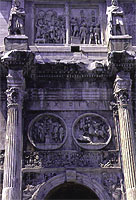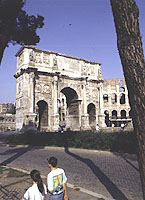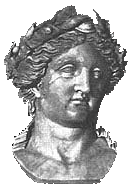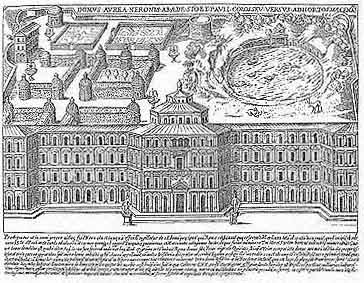Colosseum
Arch of Constantine
 This is the largest and most magnificent of the Triumphal Arches, built as giant gates through which victorious generals would lead their vanquished enemies, with chains clanking satisfactorily behind.
This is the largest and most magnificent of the Triumphal Arches, built as giant gates through which victorious generals would lead their vanquished enemies, with chains clanking satisfactorily behind.
Quality carving in the 4 C had fallen to a new low.
The one relief carving which is of the same epoch as the arch is one of Emperor Constantine addressing a sycophantic crowd.
Most of the rest were simply stolen from other monuments!
Description of the relief sculptures:
North side: (facing the Colosseum)
Upper part: the four statues are from Trajan's wars (98 - 117 AD) against Dacia – roughly corresponding with today's Romania.
The four low-relief carvings are from Marcus Aurelius' time (2 nd Century).
But the Emperor's head has been knocked off, a favorite pastime in Roman days, and substituted with Constantine's.
The four medallions are from Hadrian's time (117-138 AD).
South side:
Reliefs at the top are from Trajan's victories.
Reliefs lower down are of mythical gods and goddesses: rather shocking for a much-advertised convert to Christianity.
This all seems to have been done with undue haste, probably to please Constantine who, by conquering Maxentius, was now Emperor of the East and the West.
 Arch of Costantine Arch of CostantineHistory 312 AD. Costantine defeats his co-ruler Maxentius at the Battle of Saxa Rubra. 315 AD. This triumphal arch is erected to commemorate this victory. 1804. The Medieval buildings were torn down and the arch restored. |
Piazza del Colosseo (Map K 8)
Meta Sudans
This used to be a large mound covered with porous stone, which sweated water in a permanent stream from an underground spring.
Today one can see some of that stone covered with moss - though a few years ago it was hidden under a busy roadway.
A few years ago cars, trucks and buses were trundling past here in all their polluting glory. Now traffic has been banned as the vibrations were making the giant marble blocks of the Colosseum shimmy apart (there are no more metal grips to hold them in place - stolen in the Dark Ages to make cannon balls).
| Meta Sudans History 1st Century. In Augustus' time it was a public meeting place. A bucolic area in the valley with a stream running through it. |
Piazza del Colosseo (Map K 8)
Giant Statue of Nero
 (Statuas del Gigante Nerone) Nero was determined to have himself remembered as the most glorious of all the Caesars.
(Statuas del Gigante Nerone) Nero was determined to have himself remembered as the most glorious of all the Caesars.
What better way than a statue of oneself? He modeled this gigantic erection after one of the Seven Wonders of the Ancient World: the Colossus of Rhodes (3rd Century BC) that stood 32 meters high.
So Nero had his statue go up to 35 meters! (120 ft); it originally stood on higher ground at the vestibule gate of Nero's gargantuan Golden House.
Hadrian had the statue in all its gilded glory moved down from the hill to near the Meta Sudans fountain.
It stood here for centuries, known as the Colossus, and it gave its name to the later Flavian Amphitheater, which by the year 1000 came to be known as the Colosseum.
Of course many a (marble) head has rolled here, as each successive Emperor knocked down whichever head was up there to replace it with his own!
Domus Aurea
"Nero’s Golden House". Recently open to the public.
Emperor Nero's mansion, which was considered to be 190 meters/yards wide by 150 meters/yards deep (or the size of two or three football fields) has been recalculated as being almost twice that size, 400 by 100!
The property stretched over 150 acres. A double colonnaded street led to the palace from the entrance lodge or Vestibule, where the giant statue of the Emperor greeted the guest (the statue was moved a century later when Hadrian built the Temple of Venus and Rome). From here one got a view of the whole property, graceful hill down to the lake, pavilions dotted about - and then the mansion's staggeringly long facade, all porticoed (very much in vogue then).
It was called the Golden House because it was lavishly gilded inside and out, with frescoes painted on top of the gold by the gifted Fabullus and Plinio, artists "extraordinaires".
The house was Southern in style - a giant edition of a house of Magna Grecia, as south Italy was then called. One can see similar buildings in the mosaics at Piazza Armerina in Sicily, which are 1st and 2nd century AD. It was Nero's showplace for dazzling his guests rather than his living quarters.
 When the house was finished, Nero - self-styled Hero and Champion of everything: athletics (nobody dared win), poetry, music (he loved to sing at parties) - sighed and declared that finally he felt housed sufficiently well: in the absurdly large, outrageously expensive but beautiful Palazzo.
When the house was finished, Nero - self-styled Hero and Champion of everything: athletics (nobody dared win), poetry, music (he loved to sing at parties) - sighed and declared that finally he felt housed sufficiently well: in the absurdly large, outrageously expensive but beautiful Palazzo.
Nothing was too much, including that naked gilded statue of him at the Vestibule: all 172 ft of it!
He expropriated hundreds of houses to build his dream house - and was fiercely detested for it.
Conflicting reports said he started the Great Fire of 64 AD, which destroyed two thirds of the city; or that he hurried back from Anzio when he heard about it and feverishly helped the fire trucks. Vestiges of small blackened dwellings have been found beneath the foundations - a whole "quartiere" of Rome was gobbled up by the project. Nero, of course, blamed that new sect, the Christians, for the fire. As a result, St. Peter and St. Paul were crucified.
Nero's garden had wild beasts roaming around. A large lake where the Colosseum now stands was the scene of frolicsome water banquets; Patrician ladies were forced to loll (and more) in brothels built around the edge. Glorious bosky gardens and vineyards unfolded as far as the eye could see, to the Coelian hill opposite.
Daring new techniques were perfected in the building. As the visitor walked into the house, he was shocked by a mass of water that plunged down the far wall, ingeniously caught at the last minute by a trough below.
In the greatest room of all, another waterfall activated the circular dining platform, which turned on its axis night and day. One room had mother of pearl roof tiles with holes in them so guests could be sprinkled with perfume, or showered with petals! Most of these techniques were lost to subsequent architects for centuries. Or forever!?
All his excesses forced Nero, with the crowd clamoring for his blood, to follow his tutor's advice and kill himself by falling on his sword which his servant held. His not-brief-enough reign: 14 years (54 - 68 AD).
The house was buried by Emperors Titus and Trajan who obliterated Nero's memory by building huge public Baths on top - robbing Nero's marble floors and walls - until the Renaissance (literally "re-birth") when Raphael, Michelangelo and fellow artists were amazed by the perfect symmetry and the beauty of the painted frescoes. Their students scratched signatures - still visible today - on the vaulted ceilings, when they wiggled through a small hole with torches and rediscovered the Golden Room, and more, of this fabulous palace.
The discovery inspired yet more classical building and decoration during the Renaissance. The famous statue of the Laocoon (in the Vatican Museum) was found here. Landslides and the damp have taken their toll. Luckily the calcium deposit, which has built up over the walls (since the Renaissance) did not destroy the frescoes as was feared.
Today archeologists, working at the restoration for the Soprintendenza, realized that the calcium deposit preserved them. And now Fabullus' fabulous paintings will gradually be brought back to startle future generations.
| Domus Aurea History 64 AD. Great fire destroys much of Rome and Nero expropriates large tracts for his personal estate. Construction began under architect Severus and engineer Celer. |
Parco del Colle Oppio (Map K 7)